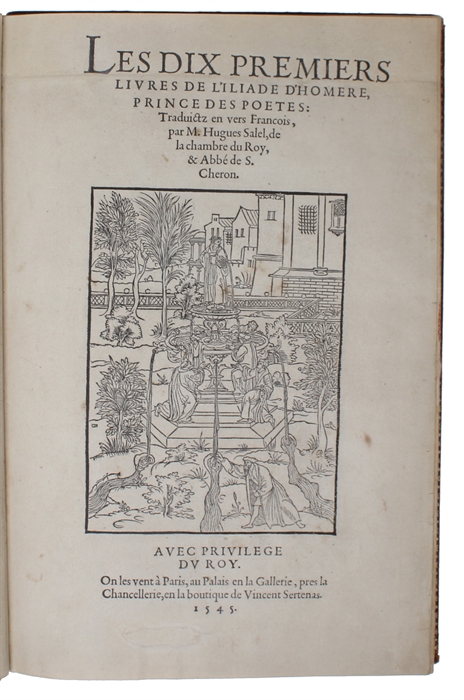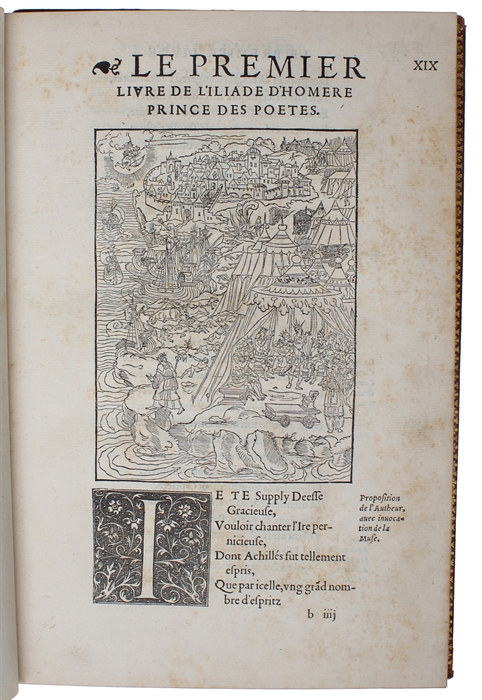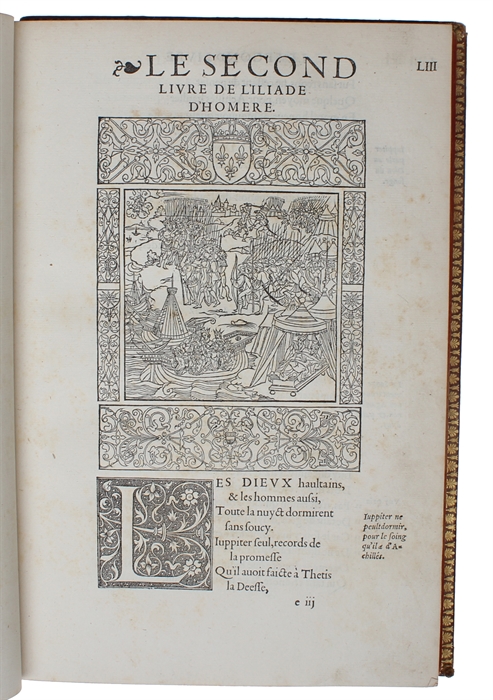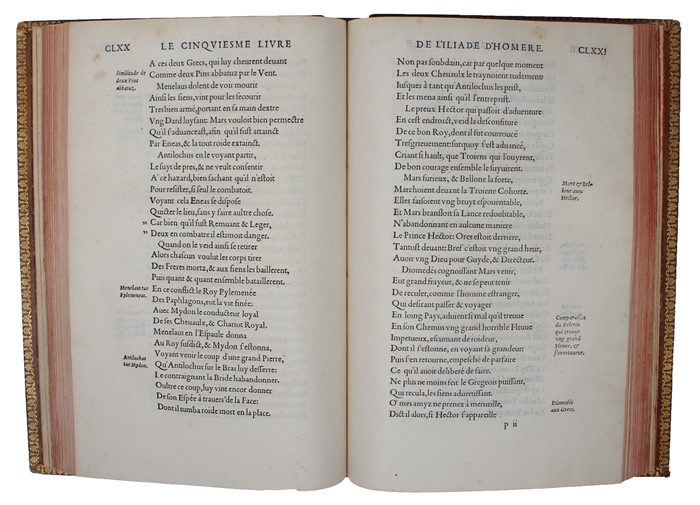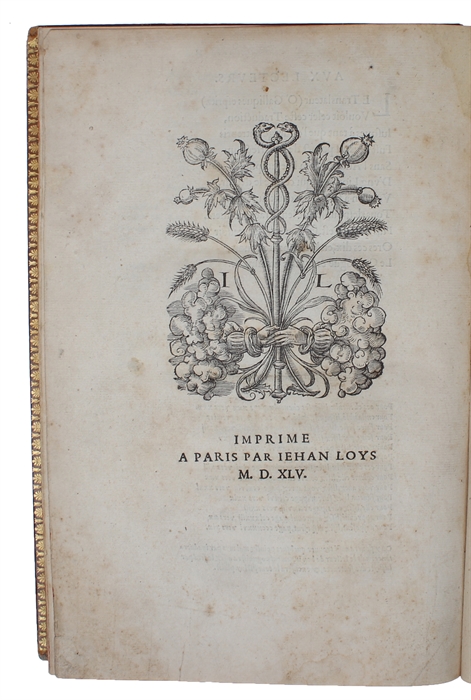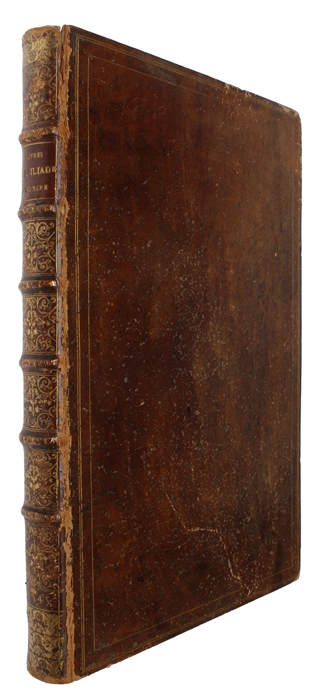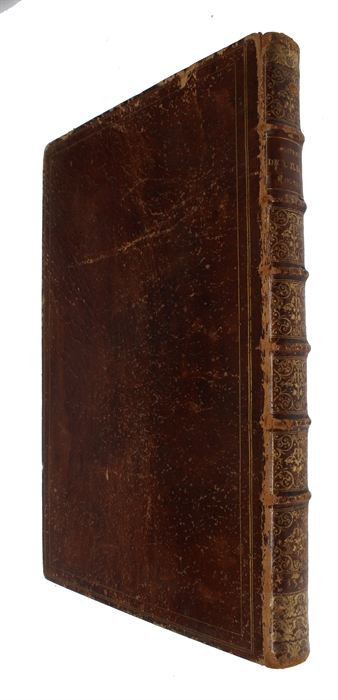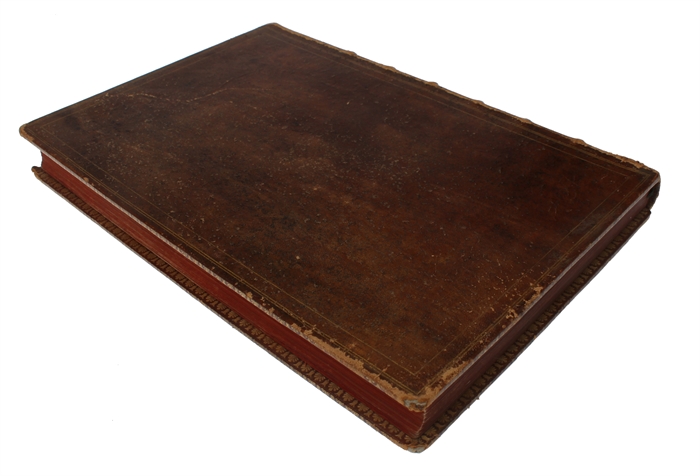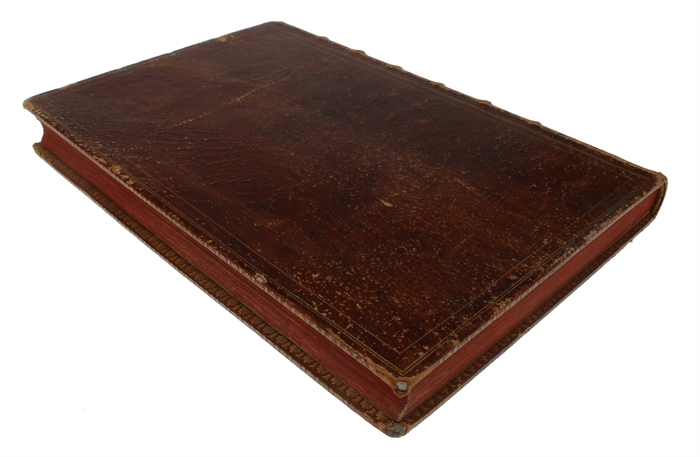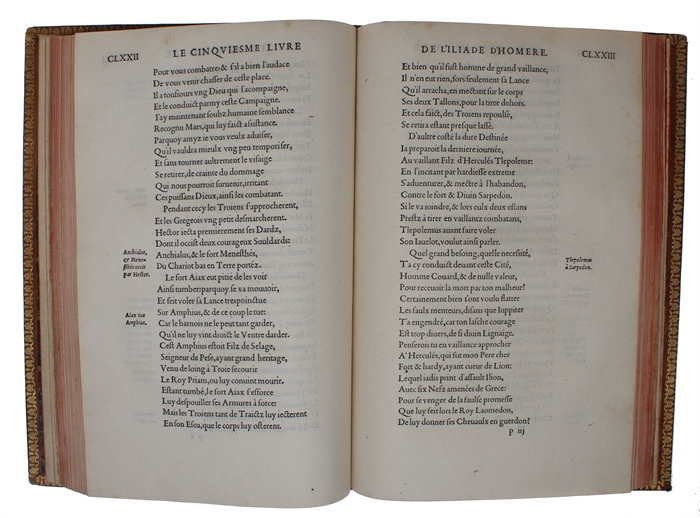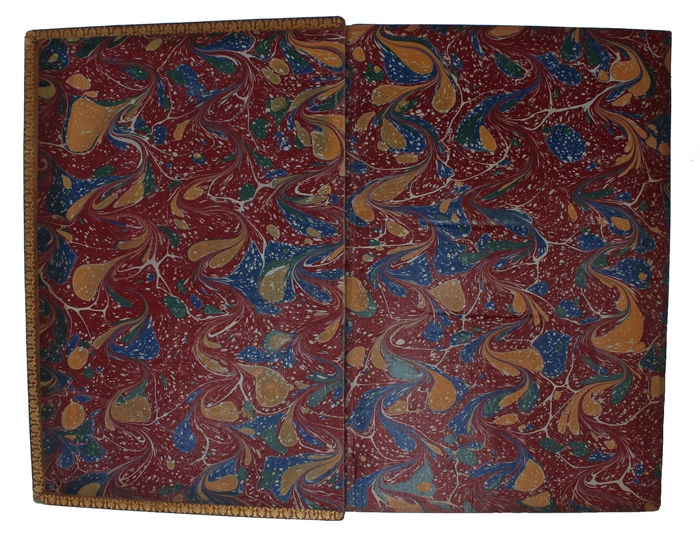THE FIRST SUCCESFUL VERSION OF THE ILIAD IN MODERN FRENCH VERSE
HOMER.
Les dix premiers livres de l’Iliade. traduictz en vers françois par M. Hugues Salel.
Paris, (Jehan Loys, for:) Vincent Sertenas, 1545.
Small folio. Nice eighteenth century full calf binding with six raised bands to richly and elegantly gilt spine (matching the style of the illustration-borders) and triple gilt line-borders to boards., spine richly gilt with seven raised bands. A bit of wear ti extremities. Title-page has been professionally restored and re-enforced, and the upper 3 cm with the first line of the title has been reinstated. Otherwise, the copy is in excellent condition, with only very mild, light brownspotting, clear, bright paper, and good margins. CCCL, (1) ff.
Roman type, italic side-notes, translator's note to the reader in verse and errata on final, unnumbered leaf. Colophon on verso of last leaf, with Loys' large woodcut device, title woodcut of Homer as the Fountain of Poetry (14,2 x 10,4 cm.), ten woodcuts, one at the beginning of each book (the first the same size as the title-llustration, the rest ab. 8,6x8,6 cm.) and all set within the same four-piece ornamental border, the upper border containing the French royal arms, the lower a small coat-of-arms (possibly Salel's), lovely large initials.
Very rare first edition of Salel's groundbreaking translation of The Iliad, constituting the first serious attempt at a modern verse rendering of either the Iliad or the Odyssey and one of the most important Homer-translations ever made. This first successful version of the Iliad in modern French verse served as the basis for other early vernacular translations, perhaps most famously the first English (Arthur Hall, 1581), which is a direct translation of Salal's. This splendid work is furthermore renowned for its beauty and is considered "one of the handsomest books printed at Paris" (Fairfax Murray). The translation includes the first 10 books of the Iliad. Salal died, before he could finish the remaining books, which were translated by Amadis Jamyn and published in 1577. "Hugues Salel was a compatriot of Clement Marot, Eustorg de Beaulieu, and Olivier de Magny. He was born, according to the Abbé Goujet, toward the end of 1504, in Casals, Quercy, in P6rigord (Cahors). He is therefore, like several of the poets of the first half of the century, a man of the South. Salel began writing verse at a very early age. At the order of the king, Francis I, he undertook a translation of the Iliad. As a reward he was made "valet de c hambre'" of the King, and in 1540 we find him as the first "abbé commendataire" of the abbey of Saint-Chéron of the diocese of Chartres. From letters of the King, dated from Fontainebleau in 1544 (January 18), we learn of the permission granted to Salel to publish his translation of the Iliad"… (Hugues Salel, Poet and Translator (uchicago.edu)) "The history of the first translations of the Homeric poems into the main European languages is fascinating, for it often reveals both the political and cultural mood of the recently created European nations. With the multiplication of printed editions of the poems, an increasingly larger pool of scholars made enthusiastic attempts to translate an ancient language into a new idiom. These new versions were not only philological achievements at that time but also a reason for national pride, since an ancient epic could be made alive within the context of new national exploits. The second half of the sixteenth century represents the high point in the assimilation of Homer into French humanist culture. Unlike England… France, and particularly Paris, quickly followed Italy's example to provide its own Homeric texts... This trend was particularly strong after the founding of the Còllege de Lecteurs Royaux by François I in 1530. This institution was established to teach the three ancient languages-Greek, Latin, and Hebrew-and to provide its students with editions and commentaries of ancient texts. Moreover, French translations also contributed to the awareness of the Homeric epics. The first successful version in modern French verse was made by Hugues Salel who translated the first ten books of the "Iliad" (From the exhibition "Translating Homer", Curated by Pablo Alvarez, Special Collections Library). Ezra Pound in his essay on Salel calls this translation of Homer "delightful… he has authenticity of conversation as would be demanded by an intelligent audience not yet laminated with aesthetics; capable of recognizing reality. He has the repetitions of the chanson de gestes. Of all the French and English versions, I think Salel alone gives any hint of some of these characteristics' (Homer: Printed editions of the Iliad and Odyssey in Greek and in Translations and Landmarks in Homeric Scholarship). "The first serious attempts at a modern verse rendering (of the Iliad and Odyssey) were made in France by Hugues Salel, with his 1545 version of the Iliad" (Gilbert Highet, The Classical tradition: Greek and Roman Influences on Western Literature, p. 114). The book is renowned for its splendid woodcuts, one at the beginning of each book. These woodcuts are set within magnificent ornamental borders containing the French royal arms and "are clearly influenced by Geoffrey Tory with their lack of shading and outline depiction of the figures, and may be the work of the Maître à l'F gothique (Brun's appellation), Mortimer's F artist (sometimes identified as the Lyonese printer François Fradin), whose woodcuts illustrate several of Denys Janot's imprints. The italianate style introduced into the French book by Tory, and continued in volumes from the press of Denys Janot, reaches its height in these illustrations." (Mortimer). The work is very rare, and we have only been able to locate three complete copies sold at aution over the last 50 years. Brunet III, 290
Harvard/Mortimer 293
Order-nr.: 59777

